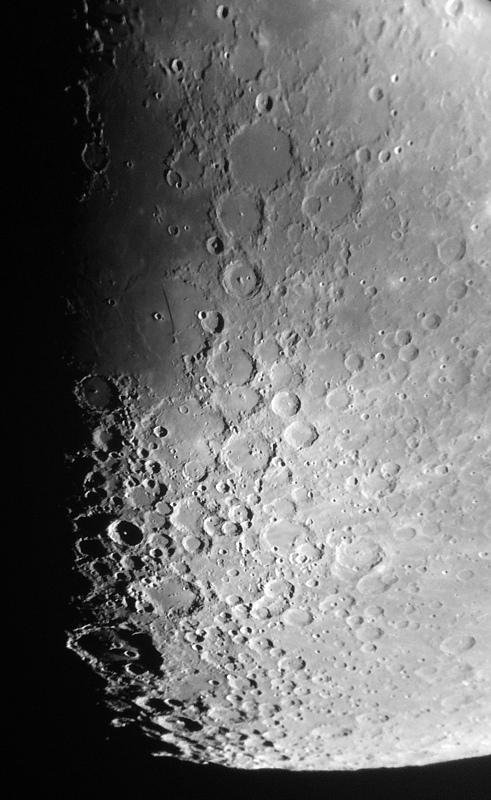Using iOS ScopeBoss AutoStar,
Quail Family, Crater Clavius
Posted: 27 May 2015
|
Open: Tuesday, 26 May 2015, 1810 MST Temperature: 91°F |
Session: 826 Conditions: Mostly clear, some clouds low in W-N, breezy |
Powered on the 8" LX200-ACF and GC Wi-Fi Adapter. Then used the iOS app "ScopeBoss" on my iPhone 5s to GOTO Venus. Used Gslew to center Venus in the 2" 24mm UWA eyepiece (83X).


Just as I looked in the eyepiece to view Venus, a jet airliner flew through the field-of-view (FOV) right over Venus. That was a cool scene. Once the contrail drifted out of the FOV the view of Venus against the bright blue sky was pretty.
Next, using ScopeBoss, slewed the telescope to Jupiter and viewed it at 83X. Then used ScopeBoss to GOTO to the Moon. The floor of the crater Clavius was just beginning to see sunlight as the sun rose over the crater wall. The tops of the interior craters were showing nice illuminated rings. 1900 MST: more of the floor of Clavius was being illuminated as the sun rose.
I then noticed that a Quail Family was near the observatory:

1925 MST: sunset (at Cassiopeia Observatory). The clouds were now in the southwest-west-north sky and the clouds in the west and north were 45° up in the sky.
Just after the sun set I took this handheld iPhone afocal 83X photo of the Moon:

Switched to the William Optics Binoviewers and did some lunar observing at 100X. Seeing at the Moon was good. Using Gslew on the light weight and small iPhone 5s was a such a joy compared to using the heavier and larger Wireless AutoStar II handcontroller:

Added the 1.6X Barlow Lens and did more lunar observing. Took these handheld iPhone afocal 166X photos (slightly cropped):


1940 MST: seeing at the Moon was beginning to worsen. Used ScopeBoss to GOTO Jupiter. Using the Binoviewers at 160X I could see that the South Equatorial Belt was about the same color and width as the North Equatorial. The four Galilean Moons were visible. Then did a GOTO Venus; the view was nice through thin clouds using the Binoviewers, 160X. The clouds were now in the southern sky as well and about 30° up.
1952 MST: GOTO Moon and began observing the crater Clavius as the sun continued to rise. Powered off the Wi-Fi adapter and ended ScopeBoss use for this night. Took this (cropped) handheld iPhone photo of the crater Clavius at 1956 MST:

2004 MST: removed the Binoviewers and switched back to the 24mm UWA eyepiece due to the poor seeing conditions and took a final look at the Moon. Then began closing up for the night.
|
Close: Tuesday, 26 May 2015, 2015 MST Temperature: 73°F |
|
I have been mentioning my first visits to "Oracle Observatory" during this 10th anniversary year. On 26-27 May 2005 I had a short visit.
Comments are welcome using Email. If you are on Twitter you can use the button below to tweet this report to your followers. Thanks.
Cassiopeia Observatory Home Page
Copyright ©2015 Michael L. Weasner / mweasner@me.com
URL = http://www.weasner.com/co/Reports/2015/05/27/index.html
